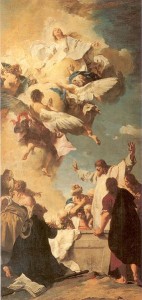 Encounter Codex presents encounters you can quickly slot into any adventure. They are system neutral and easily adapted to any edition (and other game systems for that matter) with little effort—just add stats from your favorite monster manual.
Encounter Codex presents encounters you can quickly slot into any adventure. They are system neutral and easily adapted to any edition (and other game systems for that matter) with little effort—just add stats from your favorite monster manual.
__
Features of the Chamber
• This cramped chamber has a domed ceiling nearly 15 ft. overhead. It is covered in an elegant fresco of subjects around the edge of the dome worshipping a radiant queen in the center.
• A single ray of light shoots down through the apex of the dome, illuminating a marble bust set into a niche. The bust is fixed in place.
• Rising from the floor below the niche is a stone altar, its surface angled sharply like a scribe’s desk. Nine small painted panels in three rows of three are fixed on the altar’s surface.
• The scent of burning glass singes the air.
This dungeon chamber contains one encounter element: the sliding picture puzzle…
The Sliding Picture Puzzle
This sliding picture puzzle (3 ft. by 3 ft.) conceals a key and a small cache of treasure. All eight tiles can be slid—one at a time using the blank space where a ninth tile is missing—on the grid but cannot be moved beyond the 3-square-by-3-square area or into a spot already occupied by another tile. A tile cannot slide diagonally.
When the first tile is moved, the ring of 13 servants in the fresco glows magically. Each time a tile is moved, one of the servants fades to darkness. If all 13 servants darken before the puzzle is solved, the mechanism locks, and the bust fills the chamber with an arcane mist. Those who fail to save against the gas are rendered illiterate for a time.
Reward
If the dungeoneers solve the puzzle, a bell chimes, and a hidden panel opens at the base of altar. The skeleton key inside radiates magic, and a chainmail pouch contains a modest sum of coins, several potions, and a single scroll tube. Inside the tube is a quill that never runs out of ink and allows the bearer to read and write in one or more additional languages.
Making Your Own Sliding Picture Puzzle
It’s easy. Here’s how:
1) Find a painting or illustration you like on the web. If you have a wide playing space or an especially large group, choose a high-resolution image that can be cut into big tiles that are easy to see.
2) Print it out or load the image into your favorite digital photo editor.
3) Cut it into a 3×3 pattern (or 4×4, or 5×5…).
4) Discard or erase the bottom left or bottom right cell.
5) Shuffle the image by moving the cells one space at a time, just as the players would have to when unscrambling it. Ten to fifteen moves ought to do it, depending on how large a grid you slice the image into.
6) After printing your shuffled image and cutting it out, lightly number the cells on the back. Use the numbers when you lay them out for the players.

This is a really simple and fun idea. I love it!
My son had a PC game when he was younger called Jewels of the Oracle. It was all puzzles and riddles, including one sliding panel puzzle at least. The “setting” was some ancient, pseudo-Egyptian one, with all the puzzles taking place inside a tomb or something along those lines. I wish we still had it. It’s a great tool for gaming.
I have done *exactly* this with my players in the past, and they seemed to really liked it.
My next tool: Frixion gel pens. They’re erasable using friction, but putting them in the freezer brings the ink back. Fun potentials there. ^^
Another technique I’ve used as GM is to cut up a reproduction of a landscape painting into large jigsaw pieces (say 12 in number) which the player’s find and gather together over a period of time with teasers suggesting a great artifact can be found. They then have to put the jigsaw together, identify the landscape, where it is located and then travel there (through hostile terrain of course) Will they discover the artifact when they arrive? Who knows?
@Jackdaw: That is awesome. Stolen. :)